SNPG905 Minor Project: Yoga for Stress Reduction in Dementia Care
VerifiedAdded on 2023/06/12
|28
|6692
|175
Project
AI Summary
This project investigates the effectiveness of yoga in reducing stress among healthcare workers at aged care facilities, specifically in dementia wards. The study addresses the growing problem of dementia and the associated stress experienced by healthcare workers. The research employs an explorative design with questionnaires distributed to 20 participants, analyzing pre and post-intervention stress levels. The outcomes reveal that participants who engaged in yoga experienced less stress compared to those who did not. While the study concludes that yoga can be beneficial for stress relief, it also acknowledges limitations and challenges in implementation. The project aims to provide insights into integrating yoga into healthcare practices for improved worker well-being, while also recognizing the need for further research and broader application.
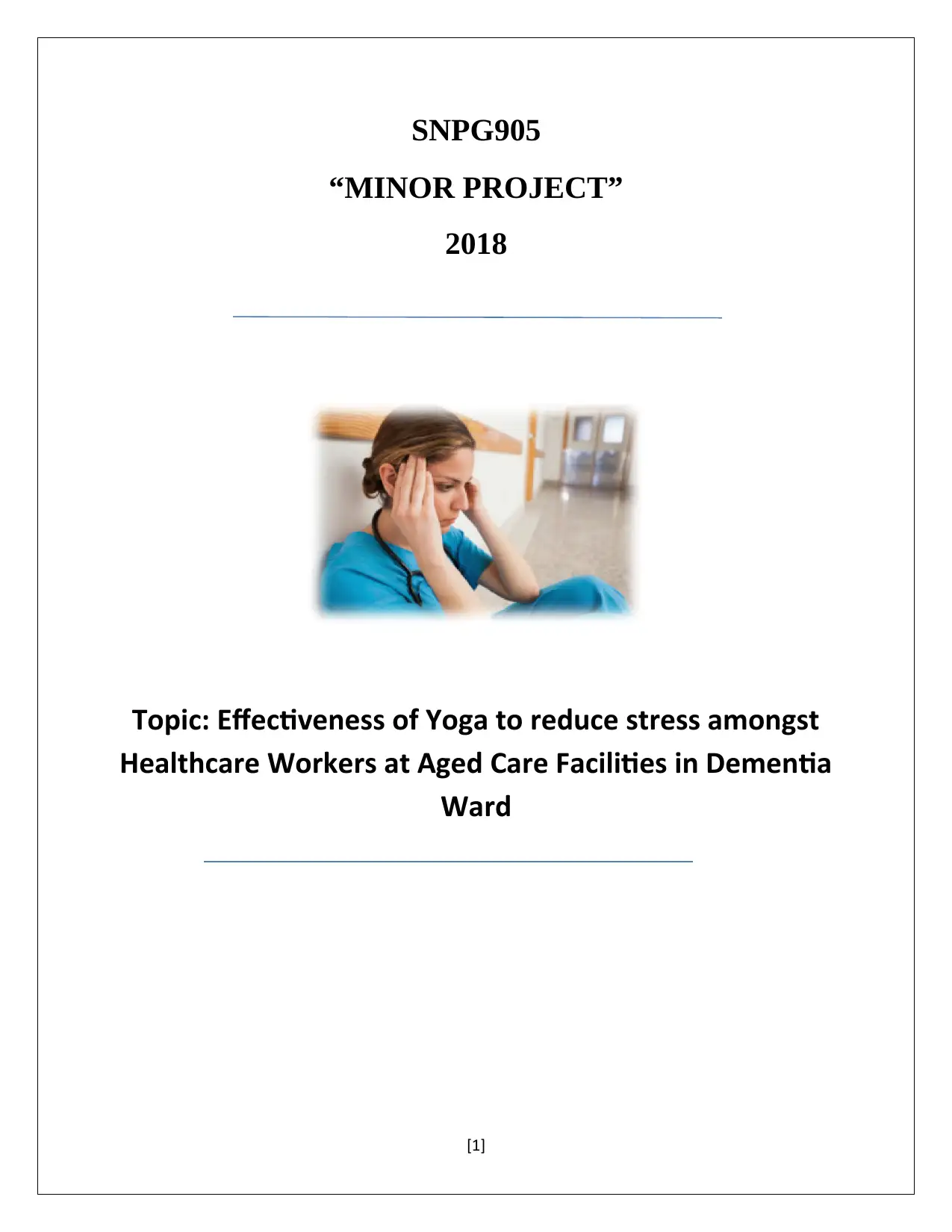
SNPG905
“MINOR PROJECT”
2018
Topic: Effectiveness of Yoga to reduce stress amongst
Healthcare Workers at Aged Care Facilities in Dementia
Ward
[1]
“MINOR PROJECT”
2018
Topic: Effectiveness of Yoga to reduce stress amongst
Healthcare Workers at Aged Care Facilities in Dementia
Ward
[1]
Paraphrase This Document
Need a fresh take? Get an instant paraphrase of this document with our AI Paraphraser
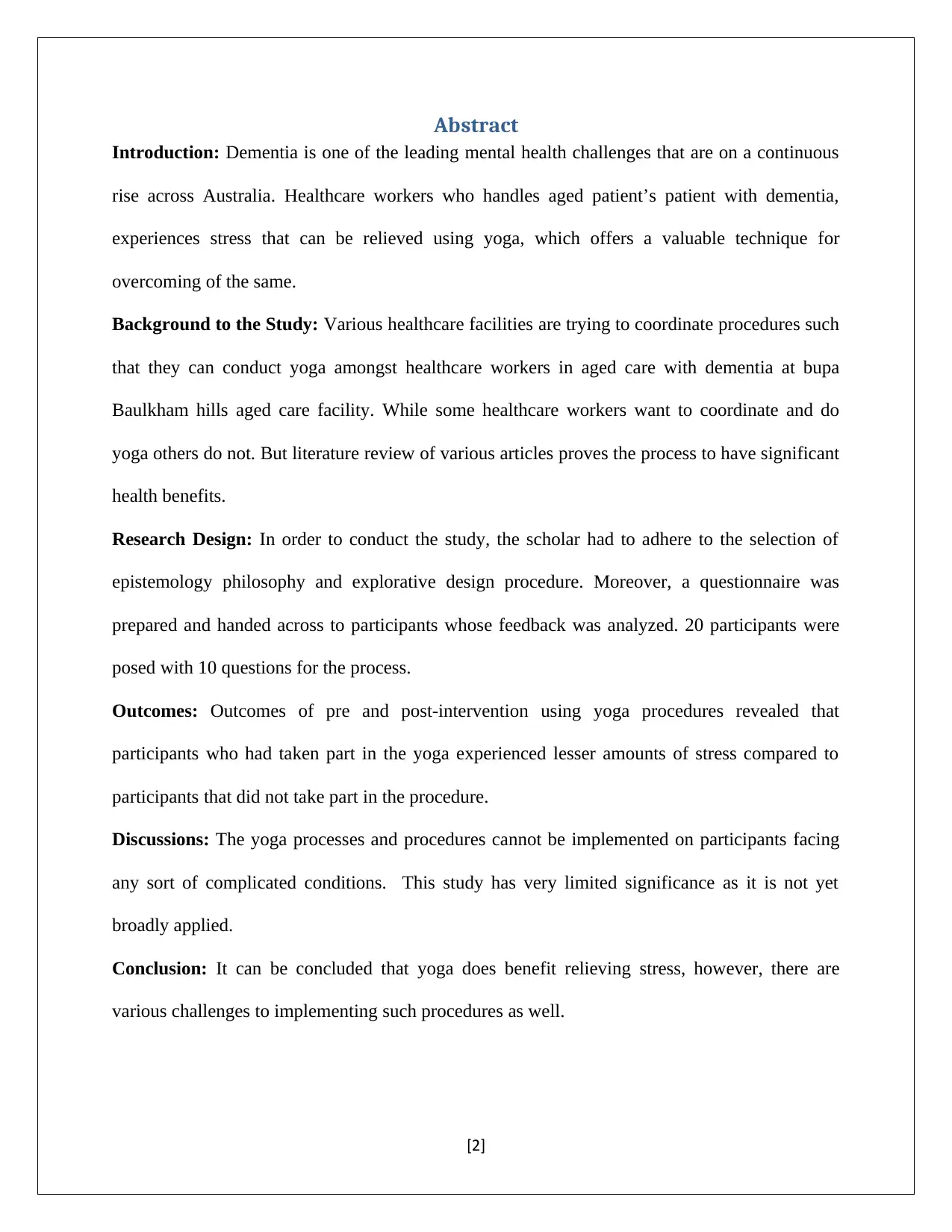
Abstract
Introduction: Dementia is one of the leading mental health challenges that are on a continuous
rise across Australia. Healthcare workers who handles aged patient’s patient with dementia,
experiences stress that can be relieved using yoga, which offers a valuable technique for
overcoming of the same.
Background to the Study: Various healthcare facilities are trying to coordinate procedures such
that they can conduct yoga amongst healthcare workers in aged care with dementia at bupa
Baulkham hills aged care facility. While some healthcare workers want to coordinate and do
yoga others do not. But literature review of various articles proves the process to have significant
health benefits.
Research Design: In order to conduct the study, the scholar had to adhere to the selection of
epistemology philosophy and explorative design procedure. Moreover, a questionnaire was
prepared and handed across to participants whose feedback was analyzed. 20 participants were
posed with 10 questions for the process.
Outcomes: Outcomes of pre and post-intervention using yoga procedures revealed that
participants who had taken part in the yoga experienced lesser amounts of stress compared to
participants that did not take part in the procedure.
Discussions: The yoga processes and procedures cannot be implemented on participants facing
any sort of complicated conditions. This study has very limited significance as it is not yet
broadly applied.
Conclusion: It can be concluded that yoga does benefit relieving stress, however, there are
various challenges to implementing such procedures as well.
[2]
Introduction: Dementia is one of the leading mental health challenges that are on a continuous
rise across Australia. Healthcare workers who handles aged patient’s patient with dementia,
experiences stress that can be relieved using yoga, which offers a valuable technique for
overcoming of the same.
Background to the Study: Various healthcare facilities are trying to coordinate procedures such
that they can conduct yoga amongst healthcare workers in aged care with dementia at bupa
Baulkham hills aged care facility. While some healthcare workers want to coordinate and do
yoga others do not. But literature review of various articles proves the process to have significant
health benefits.
Research Design: In order to conduct the study, the scholar had to adhere to the selection of
epistemology philosophy and explorative design procedure. Moreover, a questionnaire was
prepared and handed across to participants whose feedback was analyzed. 20 participants were
posed with 10 questions for the process.
Outcomes: Outcomes of pre and post-intervention using yoga procedures revealed that
participants who had taken part in the yoga experienced lesser amounts of stress compared to
participants that did not take part in the procedure.
Discussions: The yoga processes and procedures cannot be implemented on participants facing
any sort of complicated conditions. This study has very limited significance as it is not yet
broadly applied.
Conclusion: It can be concluded that yoga does benefit relieving stress, however, there are
various challenges to implementing such procedures as well.
[2]
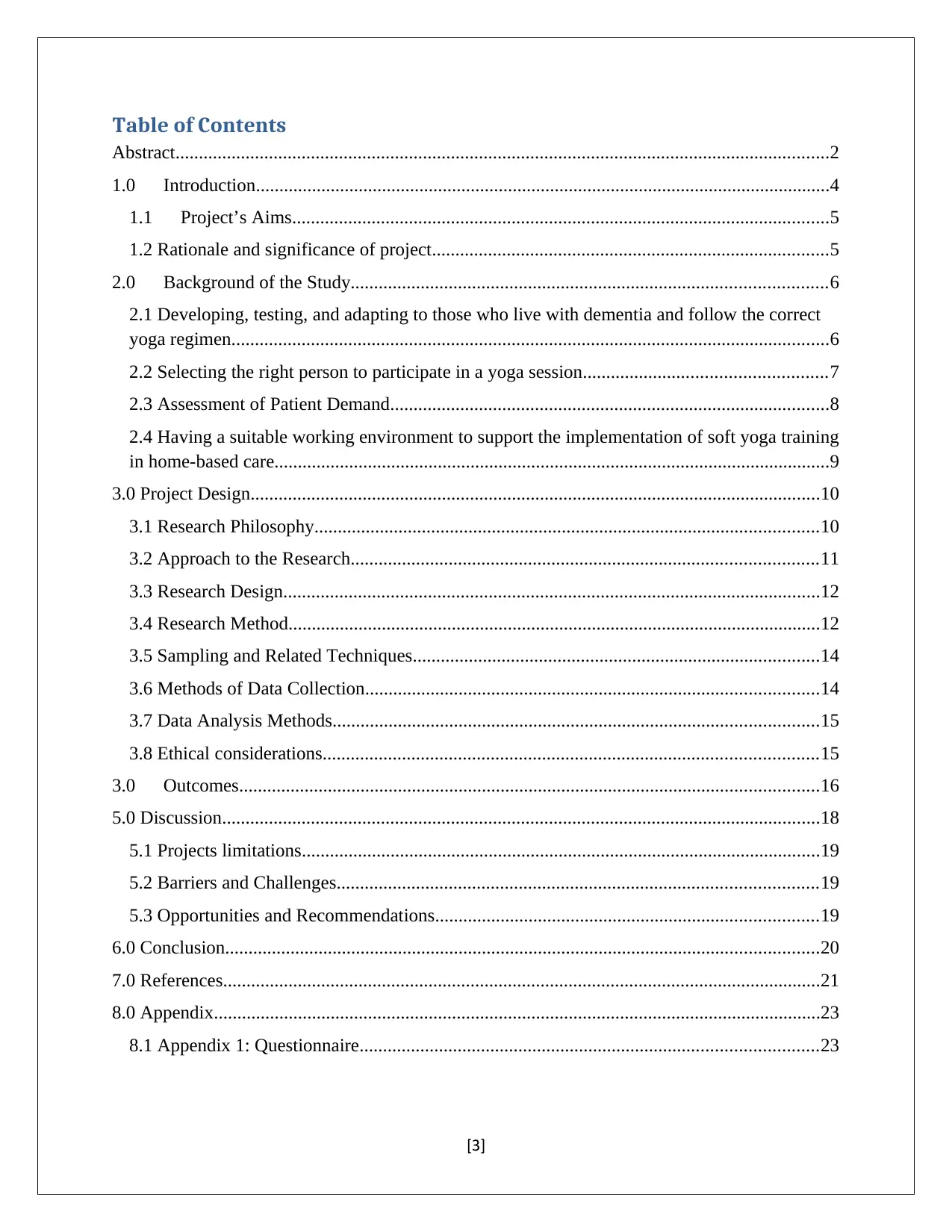
Table of Contents
Abstract............................................................................................................................................2
1.0 Introduction...........................................................................................................................4
1.1 Project’s Aims...................................................................................................................5
1.2 Rationale and significance of project.....................................................................................5
2.0 Background of the Study......................................................................................................6
2.1 Developing, testing, and adapting to those who live with dementia and follow the correct
yoga regimen................................................................................................................................6
2.2 Selecting the right person to participate in a yoga session....................................................7
2.3 Assessment of Patient Demand..............................................................................................8
2.4 Having a suitable working environment to support the implementation of soft yoga training
in home-based care.......................................................................................................................9
3.0 Project Design..........................................................................................................................10
3.1 Research Philosophy............................................................................................................10
3.2 Approach to the Research....................................................................................................11
3.3 Research Design...................................................................................................................12
3.4 Research Method..................................................................................................................12
3.5 Sampling and Related Techniques.......................................................................................14
3.6 Methods of Data Collection.................................................................................................14
3.7 Data Analysis Methods........................................................................................................15
3.8 Ethical considerations..........................................................................................................15
3.0 Outcomes............................................................................................................................16
5.0 Discussion................................................................................................................................18
5.1 Projects limitations...............................................................................................................19
5.2 Barriers and Challenges.......................................................................................................19
5.3 Opportunities and Recommendations..................................................................................19
6.0 Conclusion...............................................................................................................................20
7.0 References................................................................................................................................21
8.0 Appendix..................................................................................................................................23
8.1 Appendix 1: Questionnaire..................................................................................................23
[3]
Abstract............................................................................................................................................2
1.0 Introduction...........................................................................................................................4
1.1 Project’s Aims...................................................................................................................5
1.2 Rationale and significance of project.....................................................................................5
2.0 Background of the Study......................................................................................................6
2.1 Developing, testing, and adapting to those who live with dementia and follow the correct
yoga regimen................................................................................................................................6
2.2 Selecting the right person to participate in a yoga session....................................................7
2.3 Assessment of Patient Demand..............................................................................................8
2.4 Having a suitable working environment to support the implementation of soft yoga training
in home-based care.......................................................................................................................9
3.0 Project Design..........................................................................................................................10
3.1 Research Philosophy............................................................................................................10
3.2 Approach to the Research....................................................................................................11
3.3 Research Design...................................................................................................................12
3.4 Research Method..................................................................................................................12
3.5 Sampling and Related Techniques.......................................................................................14
3.6 Methods of Data Collection.................................................................................................14
3.7 Data Analysis Methods........................................................................................................15
3.8 Ethical considerations..........................................................................................................15
3.0 Outcomes............................................................................................................................16
5.0 Discussion................................................................................................................................18
5.1 Projects limitations...............................................................................................................19
5.2 Barriers and Challenges.......................................................................................................19
5.3 Opportunities and Recommendations..................................................................................19
6.0 Conclusion...............................................................................................................................20
7.0 References................................................................................................................................21
8.0 Appendix..................................................................................................................................23
8.1 Appendix 1: Questionnaire..................................................................................................23
[3]
⊘ This is a preview!⊘
Do you want full access?
Subscribe today to unlock all pages.

Trusted by 1+ million students worldwide
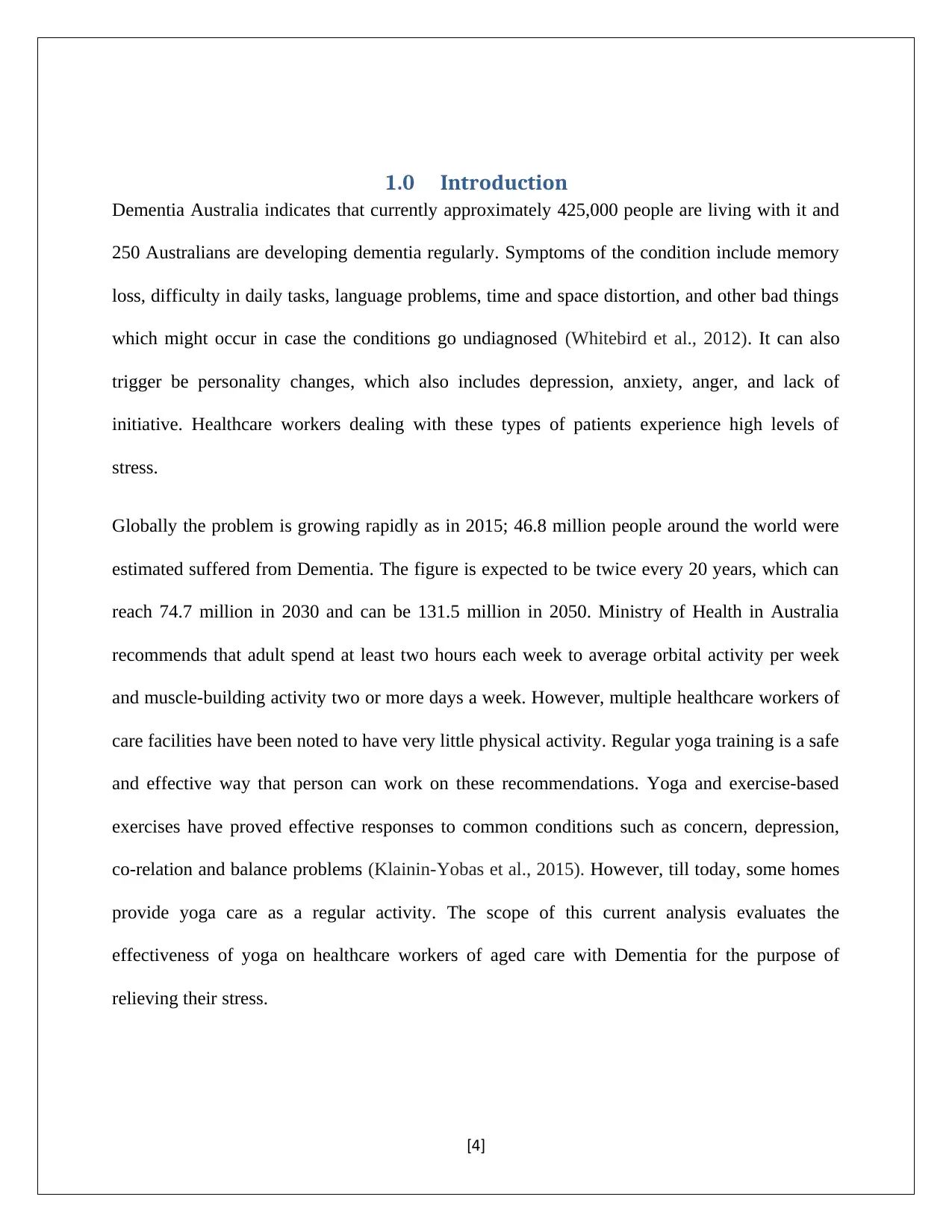
1.0 Introduction
Dementia Australia indicates that currently approximately 425,000 people are living with it and
250 Australians are developing dementia regularly. Symptoms of the condition include memory
loss, difficulty in daily tasks, language problems, time and space distortion, and other bad things
which might occur in case the conditions go undiagnosed (Whitebird et al., 2012). It can also
trigger be personality changes, which also includes depression, anxiety, anger, and lack of
initiative. Healthcare workers dealing with these types of patients experience high levels of
stress.
Globally the problem is growing rapidly as in 2015; 46.8 million people around the world were
estimated suffered from Dementia. The figure is expected to be twice every 20 years, which can
reach 74.7 million in 2030 and can be 131.5 million in 2050. Ministry of Health in Australia
recommends that adult spend at least two hours each week to average orbital activity per week
and muscle-building activity two or more days a week. However, multiple healthcare workers of
care facilities have been noted to have very little physical activity. Regular yoga training is a safe
and effective way that person can work on these recommendations. Yoga and exercise-based
exercises have proved effective responses to common conditions such as concern, depression,
co-relation and balance problems (Klainin-Yobas et al., 2015). However, till today, some homes
provide yoga care as a regular activity. The scope of this current analysis evaluates the
effectiveness of yoga on healthcare workers of aged care with Dementia for the purpose of
relieving their stress.
[4]
Dementia Australia indicates that currently approximately 425,000 people are living with it and
250 Australians are developing dementia regularly. Symptoms of the condition include memory
loss, difficulty in daily tasks, language problems, time and space distortion, and other bad things
which might occur in case the conditions go undiagnosed (Whitebird et al., 2012). It can also
trigger be personality changes, which also includes depression, anxiety, anger, and lack of
initiative. Healthcare workers dealing with these types of patients experience high levels of
stress.
Globally the problem is growing rapidly as in 2015; 46.8 million people around the world were
estimated suffered from Dementia. The figure is expected to be twice every 20 years, which can
reach 74.7 million in 2030 and can be 131.5 million in 2050. Ministry of Health in Australia
recommends that adult spend at least two hours each week to average orbital activity per week
and muscle-building activity two or more days a week. However, multiple healthcare workers of
care facilities have been noted to have very little physical activity. Regular yoga training is a safe
and effective way that person can work on these recommendations. Yoga and exercise-based
exercises have proved effective responses to common conditions such as concern, depression,
co-relation and balance problems (Klainin-Yobas et al., 2015). However, till today, some homes
provide yoga care as a regular activity. The scope of this current analysis evaluates the
effectiveness of yoga on healthcare workers of aged care with Dementia for the purpose of
relieving their stress.
[4]
Paraphrase This Document
Need a fresh take? Get an instant paraphrase of this document with our AI Paraphraser
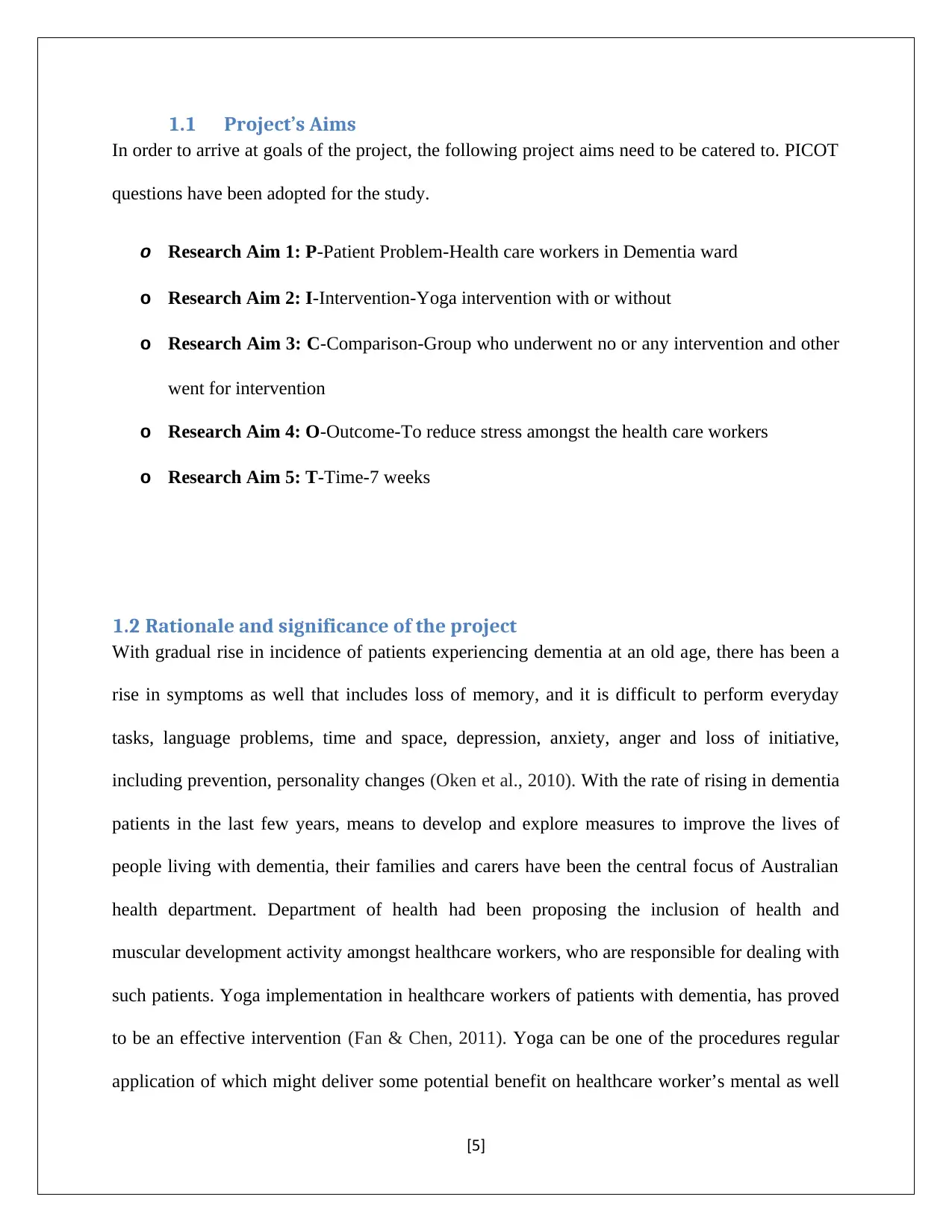
1.1 Project’s Aims
In order to arrive at goals of the project, the following project aims need to be catered to. PICOT
questions have been adopted for the study.
o Research Aim 1: P-Patient Problem-Health care workers in Dementia ward
o Research Aim 2: I-Intervention-Yoga intervention with or without
o Research Aim 3: C-Comparison-Group who underwent no or any intervention and other
went for intervention
o Research Aim 4: O-Outcome-To reduce stress amongst the health care workers
o Research Aim 5: T-Time-7 weeks
1.2 Rationale and significance of the project
With gradual rise in incidence of patients experiencing dementia at an old age, there has been a
rise in symptoms as well that includes loss of memory, and it is difficult to perform everyday
tasks, language problems, time and space, depression, anxiety, anger and loss of initiative,
including prevention, personality changes (Oken et al., 2010). With the rate of rising in dementia
patients in the last few years, means to develop and explore measures to improve the lives of
people living with dementia, their families and carers have been the central focus of Australian
health department. Department of health had been proposing the inclusion of health and
muscular development activity amongst healthcare workers, who are responsible for dealing with
such patients. Yoga implementation in healthcare workers of patients with dementia, has proved
to be an effective intervention (Fan & Chen, 2011). Yoga can be one of the procedures regular
application of which might deliver some potential benefit on healthcare worker’s mental as well
[5]
In order to arrive at goals of the project, the following project aims need to be catered to. PICOT
questions have been adopted for the study.
o Research Aim 1: P-Patient Problem-Health care workers in Dementia ward
o Research Aim 2: I-Intervention-Yoga intervention with or without
o Research Aim 3: C-Comparison-Group who underwent no or any intervention and other
went for intervention
o Research Aim 4: O-Outcome-To reduce stress amongst the health care workers
o Research Aim 5: T-Time-7 weeks
1.2 Rationale and significance of the project
With gradual rise in incidence of patients experiencing dementia at an old age, there has been a
rise in symptoms as well that includes loss of memory, and it is difficult to perform everyday
tasks, language problems, time and space, depression, anxiety, anger and loss of initiative,
including prevention, personality changes (Oken et al., 2010). With the rate of rising in dementia
patients in the last few years, means to develop and explore measures to improve the lives of
people living with dementia, their families and carers have been the central focus of Australian
health department. Department of health had been proposing the inclusion of health and
muscular development activity amongst healthcare workers, who are responsible for dealing with
such patients. Yoga implementation in healthcare workers of patients with dementia, has proved
to be an effective intervention (Fan & Chen, 2011). Yoga can be one of the procedures regular
application of which might deliver some potential benefit on healthcare worker’s mental as well
[5]
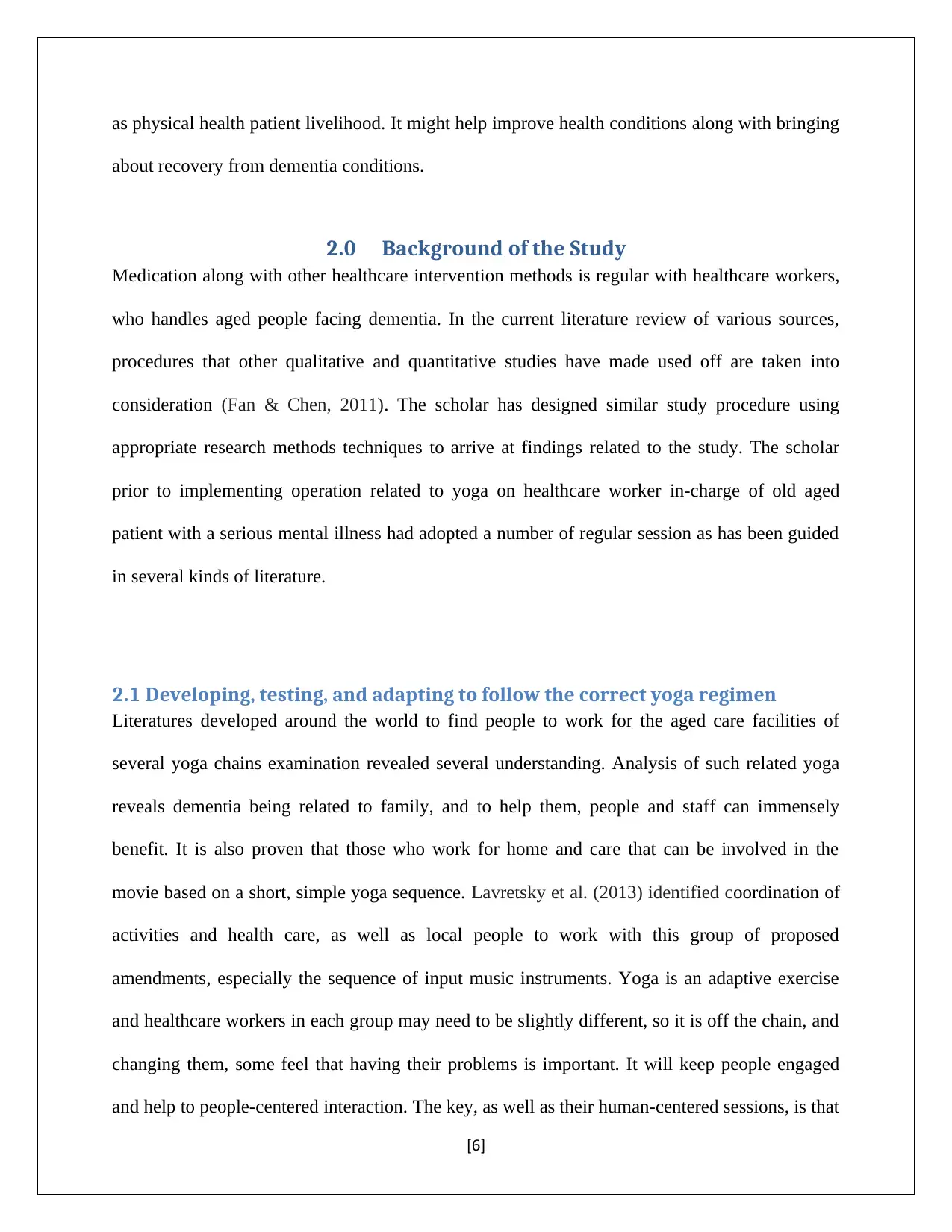
as physical health patient livelihood. It might help improve health conditions along with bringing
about recovery from dementia conditions.
2.0 Background of the Study
Medication along with other healthcare intervention methods is regular with healthcare workers,
who handles aged people facing dementia. In the current literature review of various sources,
procedures that other qualitative and quantitative studies have made used off are taken into
consideration (Fan & Chen, 2011). The scholar has designed similar study procedure using
appropriate research methods techniques to arrive at findings related to the study. The scholar
prior to implementing operation related to yoga on healthcare worker in-charge of old aged
patient with a serious mental illness had adopted a number of regular session as has been guided
in several kinds of literature.
2.1 Developing, testing, and adapting to follow the correct yoga regimen
Literatures developed around the world to find people to work for the aged care facilities of
several yoga chains examination revealed several understanding. Analysis of such related yoga
reveals dementia being related to family, and to help them, people and staff can immensely
benefit. It is also proven that those who work for home and care that can be involved in the
movie based on a short, simple yoga sequence. Lavretsky et al. (2013) identified coordination of
activities and health care, as well as local people to work with this group of proposed
amendments, especially the sequence of input music instruments. Yoga is an adaptive exercise
and healthcare workers in each group may need to be slightly different, so it is off the chain, and
changing them, some feel that having their problems is important. It will keep people engaged
and help to people-centered interaction. The key, as well as their human-centered sessions, is that
[6]
about recovery from dementia conditions.
2.0 Background of the Study
Medication along with other healthcare intervention methods is regular with healthcare workers,
who handles aged people facing dementia. In the current literature review of various sources,
procedures that other qualitative and quantitative studies have made used off are taken into
consideration (Fan & Chen, 2011). The scholar has designed similar study procedure using
appropriate research methods techniques to arrive at findings related to the study. The scholar
prior to implementing operation related to yoga on healthcare worker in-charge of old aged
patient with a serious mental illness had adopted a number of regular session as has been guided
in several kinds of literature.
2.1 Developing, testing, and adapting to follow the correct yoga regimen
Literatures developed around the world to find people to work for the aged care facilities of
several yoga chains examination revealed several understanding. Analysis of such related yoga
reveals dementia being related to family, and to help them, people and staff can immensely
benefit. It is also proven that those who work for home and care that can be involved in the
movie based on a short, simple yoga sequence. Lavretsky et al. (2013) identified coordination of
activities and health care, as well as local people to work with this group of proposed
amendments, especially the sequence of input music instruments. Yoga is an adaptive exercise
and healthcare workers in each group may need to be slightly different, so it is off the chain, and
changing them, some feel that having their problems is important. It will keep people engaged
and help to people-centered interaction. The key, as well as their human-centered sessions, is that
[6]
⊘ This is a preview!⊘
Do you want full access?
Subscribe today to unlock all pages.

Trusted by 1+ million students worldwide
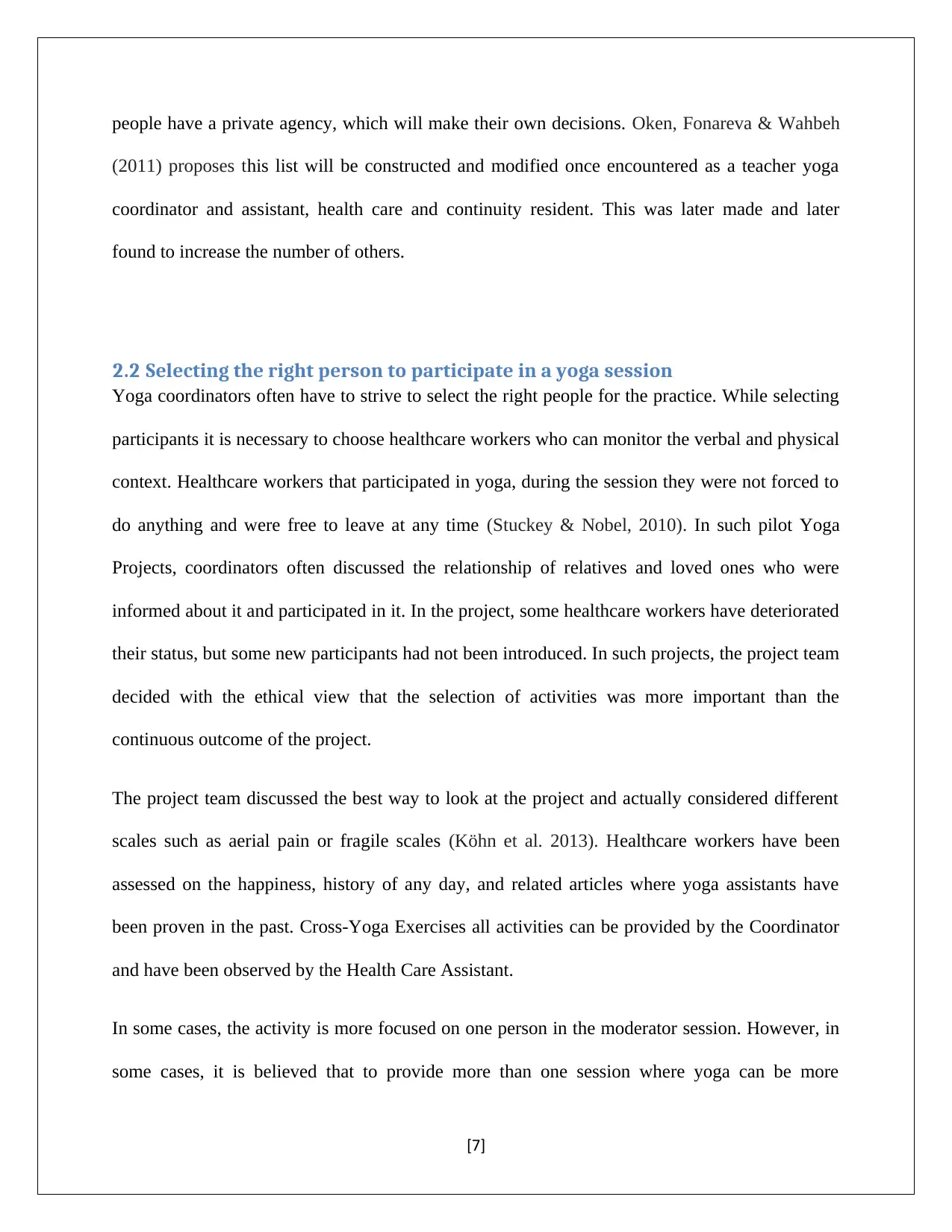
people have a private agency, which will make their own decisions. Oken, Fonareva & Wahbeh
(2011) proposes this list will be constructed and modified once encountered as a teacher yoga
coordinator and assistant, health care and continuity resident. This was later made and later
found to increase the number of others.
2.2 Selecting the right person to participate in a yoga session
Yoga coordinators often have to strive to select the right people for the practice. While selecting
participants it is necessary to choose healthcare workers who can monitor the verbal and physical
context. Healthcare workers that participated in yoga, during the session they were not forced to
do anything and were free to leave at any time (Stuckey & Nobel, 2010). In such pilot Yoga
Projects, coordinators often discussed the relationship of relatives and loved ones who were
informed about it and participated in it. In the project, some healthcare workers have deteriorated
their status, but some new participants had not been introduced. In such projects, the project team
decided with the ethical view that the selection of activities was more important than the
continuous outcome of the project.
The project team discussed the best way to look at the project and actually considered different
scales such as aerial pain or fragile scales (Köhn et al. 2013). Healthcare workers have been
assessed on the happiness, history of any day, and related articles where yoga assistants have
been proven in the past. Cross-Yoga Exercises all activities can be provided by the Coordinator
and have been observed by the Health Care Assistant.
In some cases, the activity is more focused on one person in the moderator session. However, in
some cases, it is believed that to provide more than one session where yoga can be more
[7]
(2011) proposes this list will be constructed and modified once encountered as a teacher yoga
coordinator and assistant, health care and continuity resident. This was later made and later
found to increase the number of others.
2.2 Selecting the right person to participate in a yoga session
Yoga coordinators often have to strive to select the right people for the practice. While selecting
participants it is necessary to choose healthcare workers who can monitor the verbal and physical
context. Healthcare workers that participated in yoga, during the session they were not forced to
do anything and were free to leave at any time (Stuckey & Nobel, 2010). In such pilot Yoga
Projects, coordinators often discussed the relationship of relatives and loved ones who were
informed about it and participated in it. In the project, some healthcare workers have deteriorated
their status, but some new participants had not been introduced. In such projects, the project team
decided with the ethical view that the selection of activities was more important than the
continuous outcome of the project.
The project team discussed the best way to look at the project and actually considered different
scales such as aerial pain or fragile scales (Köhn et al. 2013). Healthcare workers have been
assessed on the happiness, history of any day, and related articles where yoga assistants have
been proven in the past. Cross-Yoga Exercises all activities can be provided by the Coordinator
and have been observed by the Health Care Assistant.
In some cases, the activity is more focused on one person in the moderator session. However, in
some cases, it is believed that to provide more than one session where yoga can be more
[7]
Paraphrase This Document
Need a fresh take? Get an instant paraphrase of this document with our AI Paraphraser
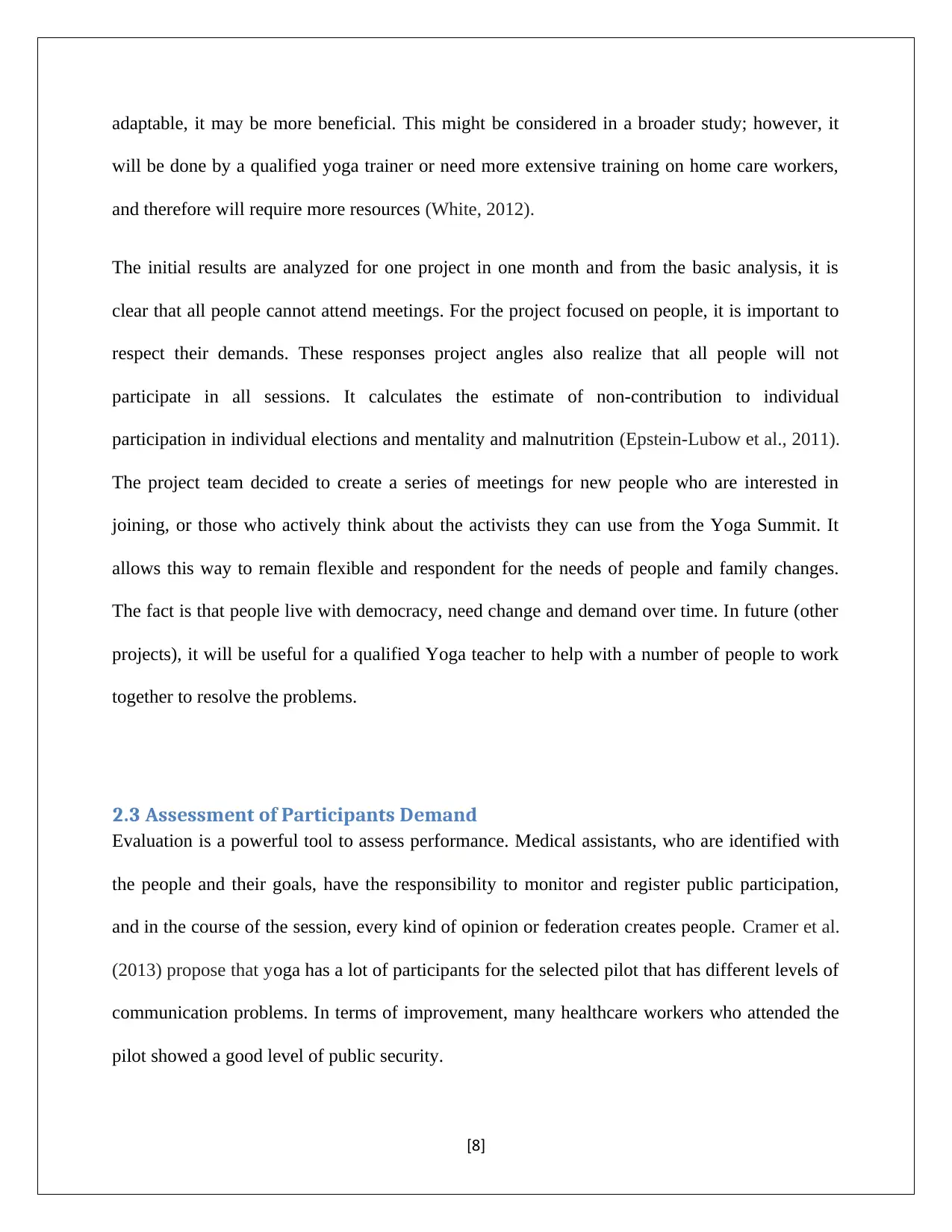
adaptable, it may be more beneficial. This might be considered in a broader study; however, it
will be done by a qualified yoga trainer or need more extensive training on home care workers,
and therefore will require more resources (White, 2012).
The initial results are analyzed for one project in one month and from the basic analysis, it is
clear that all people cannot attend meetings. For the project focused on people, it is important to
respect their demands. These responses project angles also realize that all people will not
participate in all sessions. It calculates the estimate of non-contribution to individual
participation in individual elections and mentality and malnutrition (Epstein-Lubow et al., 2011).
The project team decided to create a series of meetings for new people who are interested in
joining, or those who actively think about the activists they can use from the Yoga Summit. It
allows this way to remain flexible and respondent for the needs of people and family changes.
The fact is that people live with democracy, need change and demand over time. In future (other
projects), it will be useful for a qualified Yoga teacher to help with a number of people to work
together to resolve the problems.
2.3 Assessment of Participants Demand
Evaluation is a powerful tool to assess performance. Medical assistants, who are identified with
the people and their goals, have the responsibility to monitor and register public participation,
and in the course of the session, every kind of opinion or federation creates people. Cramer et al.
(2013) propose that yoga has a lot of participants for the selected pilot that has different levels of
communication problems. In terms of improvement, many healthcare workers who attended the
pilot showed a good level of public security.
[8]
will be done by a qualified yoga trainer or need more extensive training on home care workers,
and therefore will require more resources (White, 2012).
The initial results are analyzed for one project in one month and from the basic analysis, it is
clear that all people cannot attend meetings. For the project focused on people, it is important to
respect their demands. These responses project angles also realize that all people will not
participate in all sessions. It calculates the estimate of non-contribution to individual
participation in individual elections and mentality and malnutrition (Epstein-Lubow et al., 2011).
The project team decided to create a series of meetings for new people who are interested in
joining, or those who actively think about the activists they can use from the Yoga Summit. It
allows this way to remain flexible and respondent for the needs of people and family changes.
The fact is that people live with democracy, need change and demand over time. In future (other
projects), it will be useful for a qualified Yoga teacher to help with a number of people to work
together to resolve the problems.
2.3 Assessment of Participants Demand
Evaluation is a powerful tool to assess performance. Medical assistants, who are identified with
the people and their goals, have the responsibility to monitor and register public participation,
and in the course of the session, every kind of opinion or federation creates people. Cramer et al.
(2013) propose that yoga has a lot of participants for the selected pilot that has different levels of
communication problems. In terms of improvement, many healthcare workers who attended the
pilot showed a good level of public security.
[8]
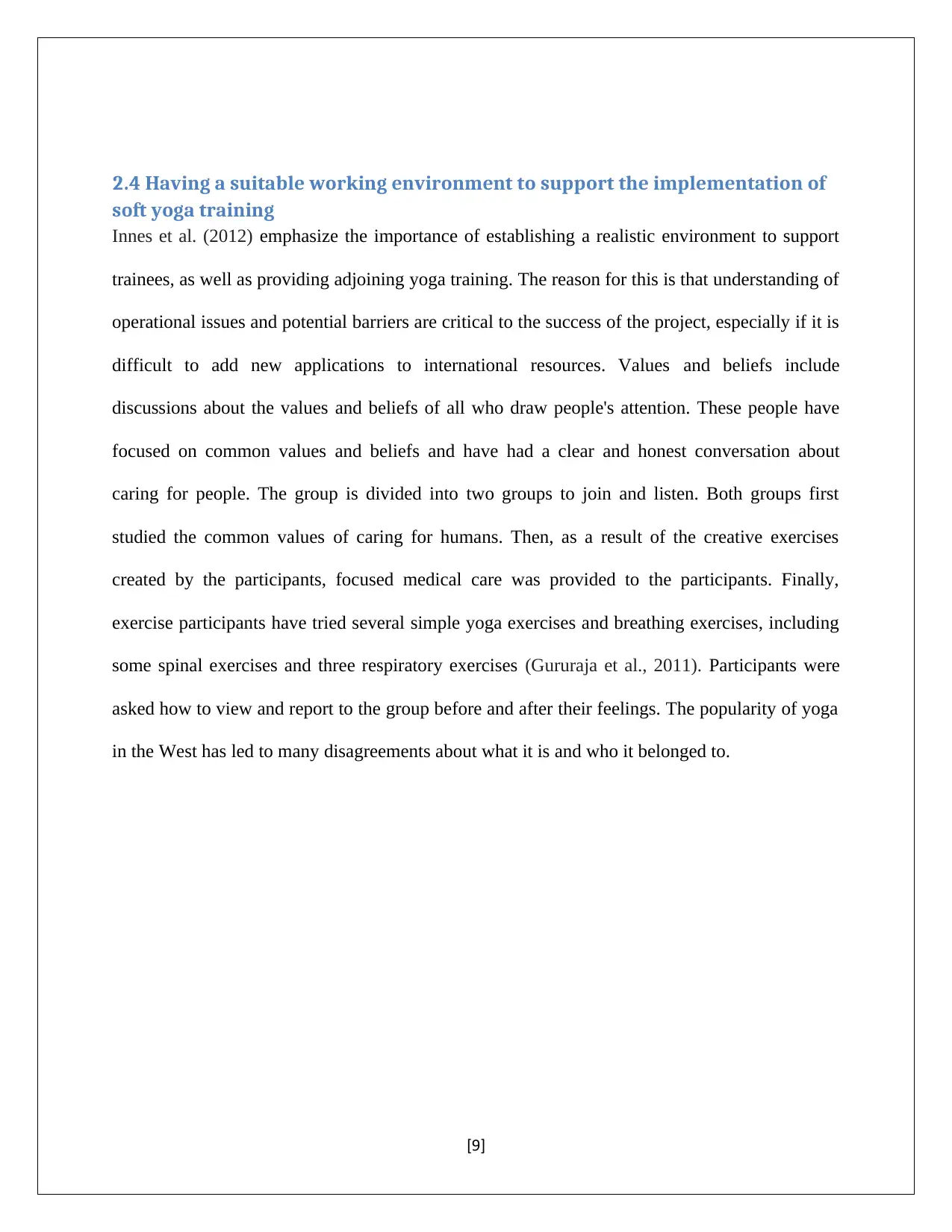
2.4 Having a suitable working environment to support the implementation of
soft yoga training
Innes et al. (2012) emphasize the importance of establishing a realistic environment to support
trainees, as well as providing adjoining yoga training. The reason for this is that understanding of
operational issues and potential barriers are critical to the success of the project, especially if it is
difficult to add new applications to international resources. Values and beliefs include
discussions about the values and beliefs of all who draw people's attention. These people have
focused on common values and beliefs and have had a clear and honest conversation about
caring for people. The group is divided into two groups to join and listen. Both groups first
studied the common values of caring for humans. Then, as a result of the creative exercises
created by the participants, focused medical care was provided to the participants. Finally,
exercise participants have tried several simple yoga exercises and breathing exercises, including
some spinal exercises and three respiratory exercises (Gururaja et al., 2011). Participants were
asked how to view and report to the group before and after their feelings. The popularity of yoga
in the West has led to many disagreements about what it is and who it belonged to.
[9]
soft yoga training
Innes et al. (2012) emphasize the importance of establishing a realistic environment to support
trainees, as well as providing adjoining yoga training. The reason for this is that understanding of
operational issues and potential barriers are critical to the success of the project, especially if it is
difficult to add new applications to international resources. Values and beliefs include
discussions about the values and beliefs of all who draw people's attention. These people have
focused on common values and beliefs and have had a clear and honest conversation about
caring for people. The group is divided into two groups to join and listen. Both groups first
studied the common values of caring for humans. Then, as a result of the creative exercises
created by the participants, focused medical care was provided to the participants. Finally,
exercise participants have tried several simple yoga exercises and breathing exercises, including
some spinal exercises and three respiratory exercises (Gururaja et al., 2011). Participants were
asked how to view and report to the group before and after their feelings. The popularity of yoga
in the West has led to many disagreements about what it is and who it belonged to.
[9]
⊘ This is a preview!⊘
Do you want full access?
Subscribe today to unlock all pages.

Trusted by 1+ million students worldwide
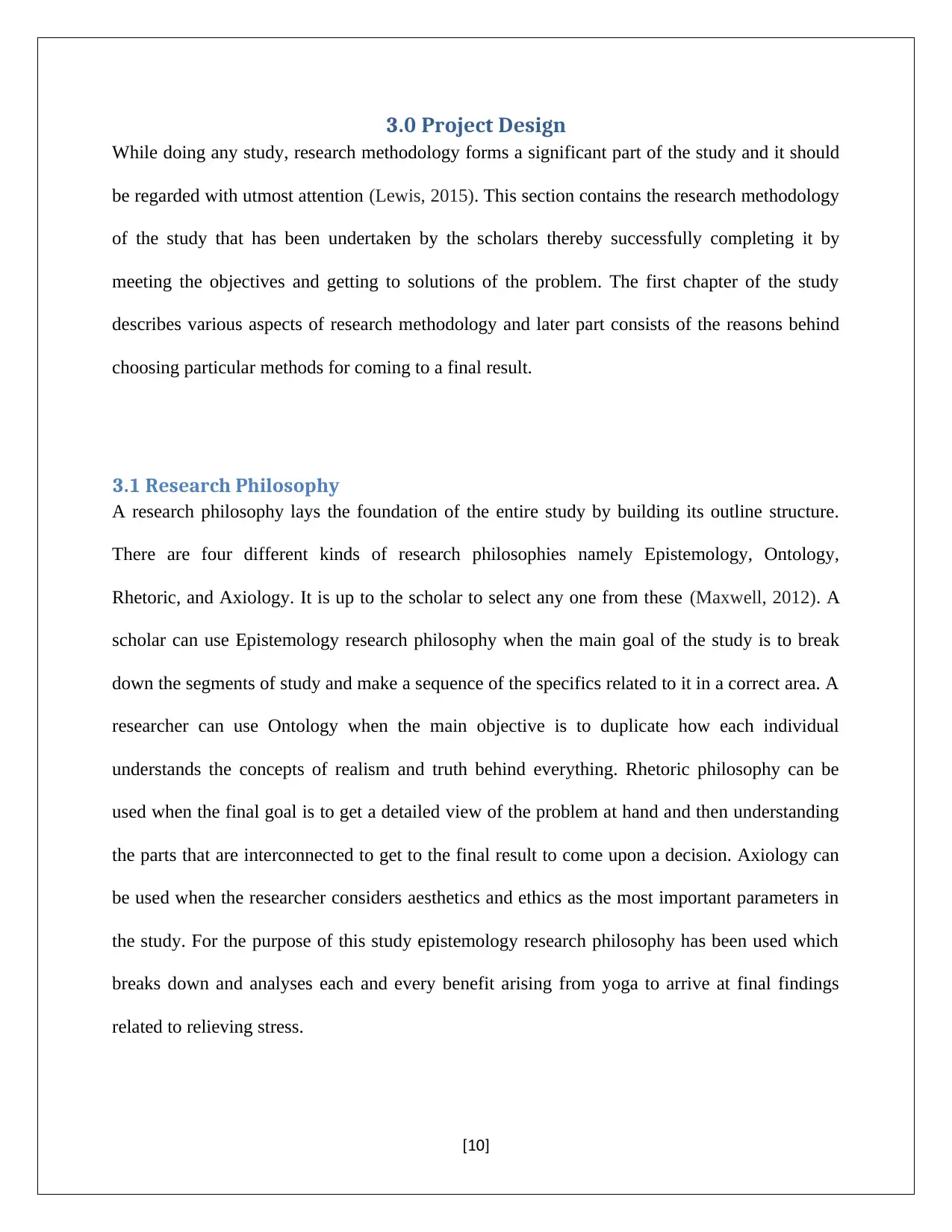
3.0 Project Design
While doing any study, research methodology forms a significant part of the study and it should
be regarded with utmost attention (Lewis, 2015). This section contains the research methodology
of the study that has been undertaken by the scholars thereby successfully completing it by
meeting the objectives and getting to solutions of the problem. The first chapter of the study
describes various aspects of research methodology and later part consists of the reasons behind
choosing particular methods for coming to a final result.
3.1 Research Philosophy
A research philosophy lays the foundation of the entire study by building its outline structure.
There are four different kinds of research philosophies namely Epistemology, Ontology,
Rhetoric, and Axiology. It is up to the scholar to select any one from these (Maxwell, 2012). A
scholar can use Epistemology research philosophy when the main goal of the study is to break
down the segments of study and make a sequence of the specifics related to it in a correct area. A
researcher can use Ontology when the main objective is to duplicate how each individual
understands the concepts of realism and truth behind everything. Rhetoric philosophy can be
used when the final goal is to get a detailed view of the problem at hand and then understanding
the parts that are interconnected to get to the final result to come upon a decision. Axiology can
be used when the researcher considers aesthetics and ethics as the most important parameters in
the study. For the purpose of this study epistemology research philosophy has been used which
breaks down and analyses each and every benefit arising from yoga to arrive at final findings
related to relieving stress.
[10]
While doing any study, research methodology forms a significant part of the study and it should
be regarded with utmost attention (Lewis, 2015). This section contains the research methodology
of the study that has been undertaken by the scholars thereby successfully completing it by
meeting the objectives and getting to solutions of the problem. The first chapter of the study
describes various aspects of research methodology and later part consists of the reasons behind
choosing particular methods for coming to a final result.
3.1 Research Philosophy
A research philosophy lays the foundation of the entire study by building its outline structure.
There are four different kinds of research philosophies namely Epistemology, Ontology,
Rhetoric, and Axiology. It is up to the scholar to select any one from these (Maxwell, 2012). A
scholar can use Epistemology research philosophy when the main goal of the study is to break
down the segments of study and make a sequence of the specifics related to it in a correct area. A
researcher can use Ontology when the main objective is to duplicate how each individual
understands the concepts of realism and truth behind everything. Rhetoric philosophy can be
used when the final goal is to get a detailed view of the problem at hand and then understanding
the parts that are interconnected to get to the final result to come upon a decision. Axiology can
be used when the researcher considers aesthetics and ethics as the most important parameters in
the study. For the purpose of this study epistemology research philosophy has been used which
breaks down and analyses each and every benefit arising from yoga to arrive at final findings
related to relieving stress.
[10]
Paraphrase This Document
Need a fresh take? Get an instant paraphrase of this document with our AI Paraphraser
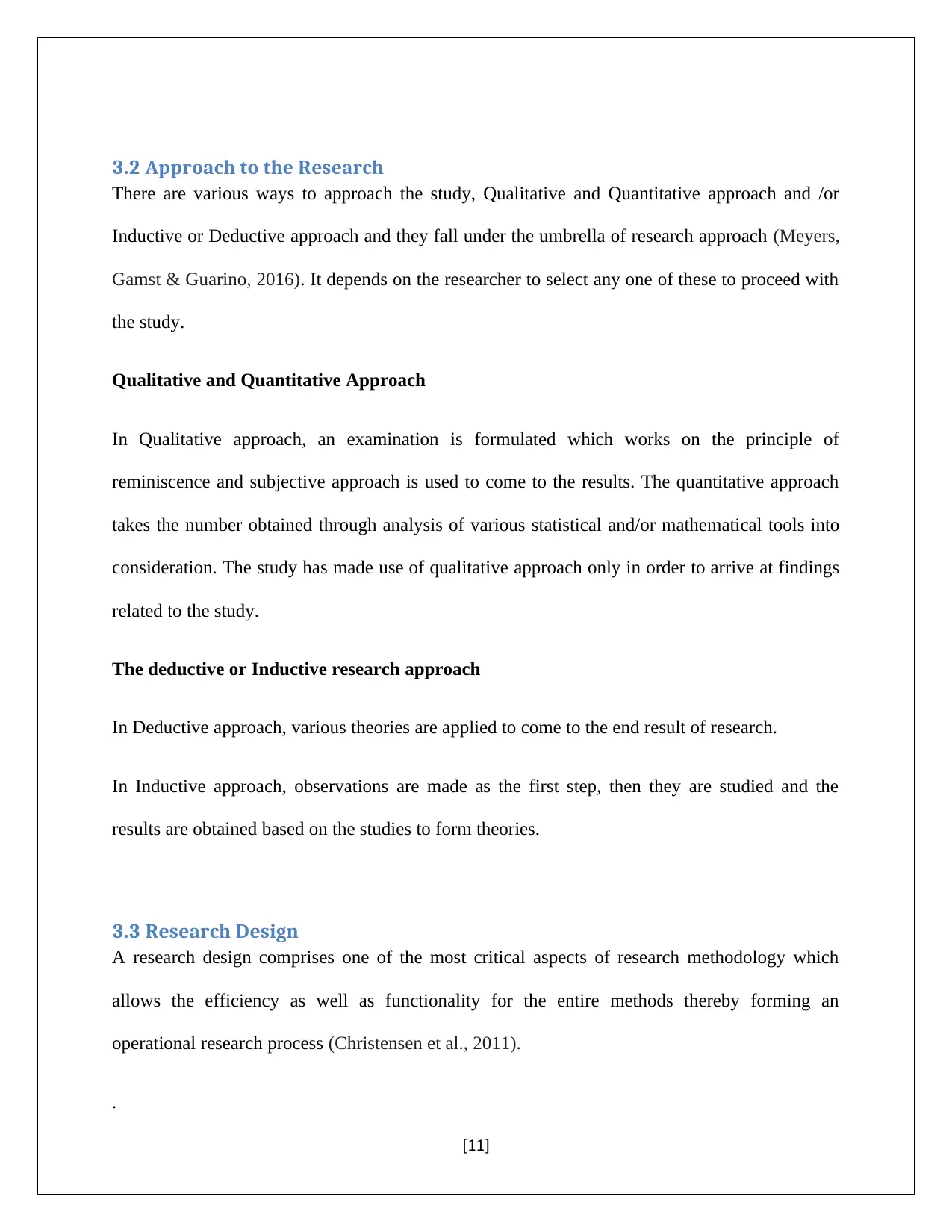
3.2 Approach to the Research
There are various ways to approach the study, Qualitative and Quantitative approach and /or
Inductive or Deductive approach and they fall under the umbrella of research approach (Meyers,
Gamst & Guarino, 2016). It depends on the researcher to select any one of these to proceed with
the study.
Qualitative and Quantitative Approach
In Qualitative approach, an examination is formulated which works on the principle of
reminiscence and subjective approach is used to come to the results. The quantitative approach
takes the number obtained through analysis of various statistical and/or mathematical tools into
consideration. The study has made use of qualitative approach only in order to arrive at findings
related to the study.
The deductive or Inductive research approach
In Deductive approach, various theories are applied to come to the end result of research.
In Inductive approach, observations are made as the first step, then they are studied and the
results are obtained based on the studies to form theories.
3.3 Research Design
A research design comprises one of the most critical aspects of research methodology which
allows the efficiency as well as functionality for the entire methods thereby forming an
operational research process (Christensen et al., 2011).
.
[11]
There are various ways to approach the study, Qualitative and Quantitative approach and /or
Inductive or Deductive approach and they fall under the umbrella of research approach (Meyers,
Gamst & Guarino, 2016). It depends on the researcher to select any one of these to proceed with
the study.
Qualitative and Quantitative Approach
In Qualitative approach, an examination is formulated which works on the principle of
reminiscence and subjective approach is used to come to the results. The quantitative approach
takes the number obtained through analysis of various statistical and/or mathematical tools into
consideration. The study has made use of qualitative approach only in order to arrive at findings
related to the study.
The deductive or Inductive research approach
In Deductive approach, various theories are applied to come to the end result of research.
In Inductive approach, observations are made as the first step, then they are studied and the
results are obtained based on the studies to form theories.
3.3 Research Design
A research design comprises one of the most critical aspects of research methodology which
allows the efficiency as well as functionality for the entire methods thereby forming an
operational research process (Christensen et al., 2011).
.
[11]
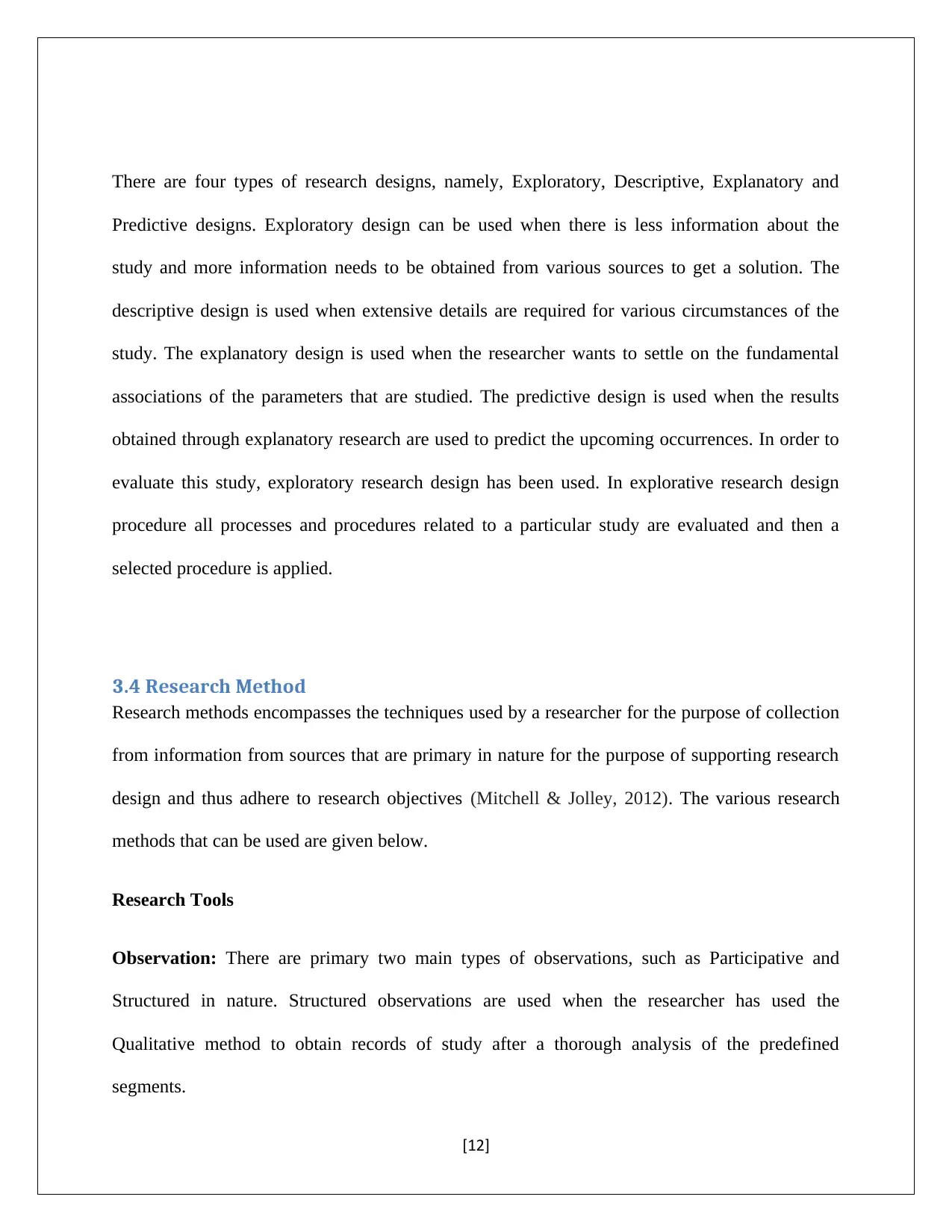
There are four types of research designs, namely, Exploratory, Descriptive, Explanatory and
Predictive designs. Exploratory design can be used when there is less information about the
study and more information needs to be obtained from various sources to get a solution. The
descriptive design is used when extensive details are required for various circumstances of the
study. The explanatory design is used when the researcher wants to settle on the fundamental
associations of the parameters that are studied. The predictive design is used when the results
obtained through explanatory research are used to predict the upcoming occurrences. In order to
evaluate this study, exploratory research design has been used. In explorative research design
procedure all processes and procedures related to a particular study are evaluated and then a
selected procedure is applied.
3.4 Research Method
Research methods encompasses the techniques used by a researcher for the purpose of collection
from information from sources that are primary in nature for the purpose of supporting research
design and thus adhere to research objectives (Mitchell & Jolley, 2012). The various research
methods that can be used are given below.
Research Tools
Observation: There are primary two main types of observations, such as Participative and
Structured in nature. Structured observations are used when the researcher has used the
Qualitative method to obtain records of study after a thorough analysis of the predefined
segments.
[12]
Predictive designs. Exploratory design can be used when there is less information about the
study and more information needs to be obtained from various sources to get a solution. The
descriptive design is used when extensive details are required for various circumstances of the
study. The explanatory design is used when the researcher wants to settle on the fundamental
associations of the parameters that are studied. The predictive design is used when the results
obtained through explanatory research are used to predict the upcoming occurrences. In order to
evaluate this study, exploratory research design has been used. In explorative research design
procedure all processes and procedures related to a particular study are evaluated and then a
selected procedure is applied.
3.4 Research Method
Research methods encompasses the techniques used by a researcher for the purpose of collection
from information from sources that are primary in nature for the purpose of supporting research
design and thus adhere to research objectives (Mitchell & Jolley, 2012). The various research
methods that can be used are given below.
Research Tools
Observation: There are primary two main types of observations, such as Participative and
Structured in nature. Structured observations are used when the researcher has used the
Qualitative method to obtain records of study after a thorough analysis of the predefined
segments.
[12]
⊘ This is a preview!⊘
Do you want full access?
Subscribe today to unlock all pages.

Trusted by 1+ million students worldwide
1 out of 28
Related Documents
Your All-in-One AI-Powered Toolkit for Academic Success.
+13062052269
info@desklib.com
Available 24*7 on WhatsApp / Email
![[object Object]](/_next/static/media/star-bottom.7253800d.svg)
Unlock your academic potential
Copyright © 2020–2025 A2Z Services. All Rights Reserved. Developed and managed by ZUCOL.



